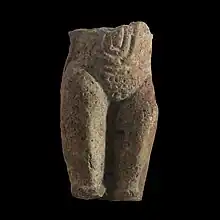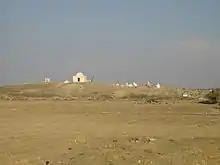Tell Fekheriye
Tell Fekheriye (Arabic: تل الفخيرية) (often spelled as Tell el-Fakhariya or Tell Fecheriye, among other variants) is an ancient site in the Khabur river basin in al-Hasakah Governorate of northern Syria.[1] It is securely identified as the site of Sikkan, attested since c. 2000 BC.[2] While under an Assyrian governor c. 1000 BC it was called Sikani.[3][4] Sikkan was part of the Syro-Hittite state of Bit Bahiani in the early 1st millennium BC. In the area, several mounds, called tells, can be found in close proximity: Tell Fekheriye, Ras al-Ayn, and 2.5 kilometers east of Tell Halaf, site of the Aramean and Neo-Assyrian city of Guzana. During the excavation, the Tell Fekheriye bilingual inscription was discovered at the site, which provides the source of information about Hadad-yith'i.[5]
تل الفخيرية | |
Tell Fekheriye, Syria | |
 Tell Fekheriye Shown within Syria | |
| Alternative name | Sikkan |
|---|---|
| Location | Ras al-Ayn, Al-Hasakah Governorate, Syria |
| Region | Upper Mesopotamia |
| Coordinates | 36°50′24″N 40°4′7″E |
| Type | Settlement |
| Site notes | |
| Excavation dates | 1929, 1940, 1955, 2001, 2006-2010 |
| Archaeologists | Felix Langenegger, Hans Lehmann, Calvin W. McEwan, A. Pruß, Anton Moortgat |
| Condition | In ruins |
%252C_Tell_Fakhariyah%252C_Pre-pottery_Neolithic_B%252C_9000-7000_BC%252C_gypsum_with_bitumen_and_stone_inlays_-_Oriental_Institute_Museum%252C_University_of_Chicago_-_DSC07633.JPG.webp)
%252C_Tell_Fakhariyah%252C_Pre-pottery_Neolithic_B%252C_9000-7000_BC%252C_gypsum_with_bitumen_and_stone_inlays_-_Oriental_Institute_Museum%252C_University_of_Chicago_-_DSC07636.JPG.webp)
Exhibited in the Oriental Institute Museum, Chicago, USA.
In the early 20th century Tell Fekheriye was suggested as the site of Washukanni, the capital of Mitanni, but the claim is unconfirmed.[6][7] Many scholars opposed this theory including Michael Roaf, Peter Akkermans, David Oates, Joan Oates and Edward Lipiński.[2][8][9] However this identification received a new support by Stefano de Martino due to recent archaeological excavations by a German team led by Mirko Novák and Dominik Bonatz.[10]
History
The site showed signs of occupation in the Neolithic period. The limited excavations so far conducted have shown substantial developments in the Middle Assyrian and Neo-Assyrian periods, with only scattered pottery sherds from the earlier Mitanni periods. The site was also occupied in the Roman-Byzantine period.[11]
Proposed association with Washukanni

The Neo-Assyrian city Sikan at nearby Ra's al-'Ayn was identified by Dietrich Opitz as the capital of Mitanni, Washukanni.[12][13] The name Sikan was then believed to be an Assyrianized version of its Hurrian, or Indo-Aryan original, becoming (Wa-)Sikan(-ni). No epigraphic, glyphic or other archaeological evidence supporting this identification has yet emerged from excavations at this or other sites.[14] The identification thus rests on a purely etymologic basis. The etymology is challenged by Edward Lipiński, who points out that Sikan is a Semitic name (meaning stele) already attested for the site circa 2000 BC.[2][15] A clay tablet sent from Washukanni to Egypt was chemically analyzed and compared with samples from Sikan; the result was "no-match".[14][16]
Archaeology

The site is around 90 hectares in area, 12 of which are a high mound. Tell Fakhariyah came to the attention of Max von Oppenheim in the early 1900s. In 1929, during his excavations at Tell Halaf, he dispatched Felix Langenegger and Hans Lehmann to the site to do a field survey, resulting in the production of a contour map.[17] In 1940, a team from the Oriental Institute of Chicago and the Boston Museum of Fine Arts, led by Calvin W. McEwan, and which included Harold D. Hill, worked for a short period there, conducted several soundings, developed a contour map of the site, and collected various pottery and epigraphic objects. The later included twelve tablets and some fragments. One of the Middle Assyrian tablets, from c. 13th century BC, indicated that the town's name was Dunnu at that time. The areas explored were mainly Middle Assyrian and Neo-Assyrian. [18]
In 1955, Anton Moortgat conducted two soundings at Tell Fakhariyah, dated to the Mitanni empire period.[19][20] A brief excavation occurred in 2001 by a team of University of Halle-Wittenberg and the Syrian Directorate-General of Antiquities and Museums led by A. Pruß.[21] After a survey in 2005, a team from the Free University of Berlin and SAHI - Slovak archeological and historical institute and the Syrian Directorate-General of Antiquities and Museums resumed work at Tell Fakhariyah for a month in 2006. Excavations continued in 2007 for a period of 8 weeks.[22][23][24] In the 2009 season, 11 Middle Assyrian cuneiform tablets were recovered from a layer early in the post-Mitanni period of the site.
In 2010, 40 texts and text fragments were found in the same context.[25][26] Preliminary translation shows them to be administrative in nature. Eponyms link some to the 13th century BC reigns of Middle Assyrian rulers Shalmaneser I and Tukulti-Ninurta I. A number of related sealings and a few seals were also found.[27]
References
- L. Braidwood, Stone artifacts in C McEwan, Soundings at Tell Fakhariyah(Chicargo University Press, 1958 page 53-55.
- Lipiński, Edward (2000). The Aramaeans: Their Ancient History, Culture, Religion. Peeters Publishers. p. 120. ISBN 978-90-429-0859-8.
- Postgate, J. N. “The Land of Assur and the Yoke of Assur.” World Archaeology, vol. 23, no. 3, 1992
- Gropp, Douglas M., and Theodore J. Lewis. “Notes on Some Problems in the Aramaic Text of the Hadd-Yithʿi Bilingual.” Bulletin of the American Schools of Oriental Research, no. 259, 1985, pp. 45–61
- Dušek, Jan and Mynářová, Jana. "Tell Fekheriye Inscription: A Process of Authority on the Edge of the Assyrian Empire", The Process of Authority: The Dynamics in Transmission and Reception of Canonical Texts, edited by Jan Dušek and Jan Roskovec, Berlin, Boston: De Gruyter, pp. 9-40, 2016
- K. Lawson Younger (2007). Ugarit at Seventy-Five. p. 146. ISBN 9781575061436.
- Edward, Lipiński (2016). "Hurrians and Their Gods in Canaan". Rocznik Orientalistyczny/Yearbook of Oriental Studies.
- D. T. Potts (2012). A Companion to the Archaeology of the Ancient Near East. p. 570. ISBN 9781444360776.
- David Oates; Joan Oates; Helen McDonald (1997). Excavations at Tell Brak, Volume 1. p. 143. ISBN 9780951942055.
- De Martino, Stefano, 2018. "Political and Cultural Relations between the Kingdom of Mittani and its Subordinated Polities in Syria and Southeast Anatolia", in Changing Faces of Kingship in Syria-Palestine 1500-500 BCE, Ugarit Verlag, p. 38: "...the recent German archaeological excavations at Tell Fekheriye support the assumption that the capital of Mittani, Wassukkanni, was located there..." See also Novák (2013: 346) and Bonatz (2014).
- Bonatz, Dominik. "Tell Fekheriye. A Synopsis of Excavations and Ongoing Research Questions." Archaeological Explorations in Syria 2000-2011: Proceedings of ISCACH-Beirut 2015, pp 101-116, 2018
- D. Opitz, Die Lage von Wassuganni, Zeitschrift für Assyriologie und verwandte Gebiete, vol. 37, 1927
- Bertille Lyonnet and Xavier Faivre, The Settlement Pattern of the Western Upper Khabur from the Old Babylonian Period to the End of the Mittani Era. (THE SETTLEMENT PATTERN OF THE WESTERN UPPER KHABUR) p213.
- Peter M. M. G. Akkermans, Glenn M. Schwartz (2003). The Archaeology of Syria: From Complex Hunter-Gatherers to Early Urban Societies (c.16,000-300 BC). p. 327. ISBN 9780521796668.
- Edward Lipinski, Studies in Aramaic Inscriptions and Onomastics, Peeters Publishers, 1994, ISBN 90-6831-610-9
- A. Dobel, F. Asaro, H. V. Michel, "Neutron Activation Analysis and the Location of Washshukanni", Orientalia, vol. 46, pp. 375–382, 1977
- Max Freiherr von Oppenheim, "Der Tell Halaf", Eine neue Kultur im ältesten Mesopotamien, F. A. Brockhaus, 1931
- C. W. McEwan, L. S. Braidwood, H. Frankfort, H. G. Güterbock, R. C. Haines, H. J. Kantor, and C. H. Kraeling, "Soundings at Tell Fakhariyah", Oriental Institute Publication 79, 1957
- A. Moortgat, "Vorläufiger Bericht über eine Grabung auf dem Tell Fecherije 1955", AAS, vol. 6, pp. 39-50, 1956
- A. Moortgat, "Archäologische Forschungen der Max Freiherr von Oppenheim-Stiftung im nördlichen Mesopotamien 1956", AAS, vol. 7, pp. 17-30, 1957
- A. Pruss and Abd al-Masih Bagdo, "Tell Fecheriye. Bericht über die erste Kampagne der deutsch-syrischen Ausgrabungen 2001", MDOG, vol. 134, pp. 311-329, 2002
- D. Bonatz and P. Bartl, "Preliminary Report of the excavations at Tell Fekheriye in 2006 and 2007", in: Chronique Archéologique en Syrie, pp. 175-185, 2007
- D. Bonatz, "Tell Fecheriye 2006 - Neue Ausgrabungen an altbekannter Stätte", in: Alter Orient aktuell, vol. 8, pp. 4-8, 2008
- D.Bonatz et al., "Bericht über die erste und zweite Grabungskampagne in Tell Fekheriye 2006 und 2007", MDOG, vol. 140, pp. 89-135,2008
- Hulínek, Drahoslav; Kendrala, Daniel; Lieskovský, Tibor. "4. Geodetic surveyes and topography at the Tell Fekheriye location". In: D. Hulínek/D. Bonatz/M. Kováč (Eds.): Archeology on Three Continents 2006 – 2011 (5 Years of the Slovak Archeological and Historical Institute Sahi). Bratislava 2015, 59-70.
- Bartl, Peter (January 2012). "Tell Fekheriye 2010: Report on the 4th Excavation Campaign".
- Bonatz, Dominik. Middle Assyrian Seal Motifs from Tell Fekheriye (Syria), Berlin, Boston: De Gruyter, 2021 ISBN 978-3-11-069123-8
Further reading
- R. Zadok, "Remarks on the Inscription of hdyscy from Tall Fakhariya", Tel Aviv, vol. 9, pp. 117–129, 1982
- T. Muraoka, "The Tell-Fekherye Bilingual Inscription and Early Aramaic", Abr-Naharain, vol. 22, pp. 79–117, 1983–84
- B. Müller-Neuhof, "Anthropomorphic Statuettes from Tell Fakhariyah: Arguments for Their Possible PPNB Origin", Neo-Lithics 1, pp. 37 – 43, 2007
- Dominik Bonatz, "Tell Fekheriye in the Late Bronze Age: Archaeological Investigations into the Structures of Political Governance in the Upper Mesopotamian Piedmont", in: Dominik Bonatz (Ed.), The Archaeology of Political Spaces. The Upper Mesopotamian Piedmont in the Second Millennium BC, Berlin, Boston: De Gruyter, pp. 61–84, 2014